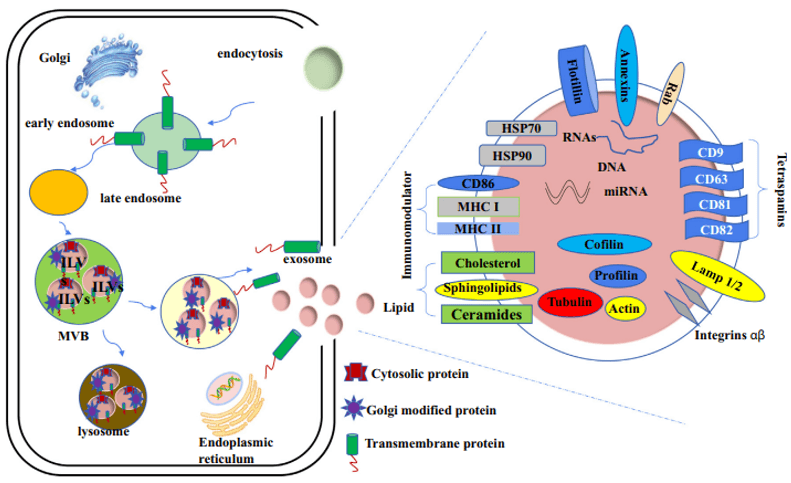Isolation and Extraction of Exosomes Services
Creative Bioarray can successfully isolate and purify biological samples and exosomes in cultured cells. Our service provides a variety of separation methods for customers to choose, and guarantees to provide customers with suitable solutions. We have established a mature agreement and can provide exosome isolation services with a fast turnaround time according to your requirements.
Exosomes Isolation Technology
Exosomes are cell-derived nanovesicles that can carry nucleic acids, proteins, lipids, and other molecules from the cells of their origin. Exosomes are found in almost all biological fluids, including blood, saliva, urine, semen, sputum, breast milk, and cerebrospinal fluid. Unlike tissue samples, they can be collected non-invasively over a long period of time, allowing continuous monitoring of disease progression and response to treatment. Compared with other circulating biomarkers, exosomes also have several advantages. They are abundant (thousands to billions per microliter of biological fluid), and their durability indicates that their internal integrity can be maintained through several freeze-thaw cycles. Differential centrifugation (including gradient ultracentrifugation) is a standard exosome separation technique, which relies on multiple centrifugation steps to remove whole cells, cell debris and extracellular vesicles (EV) Subgroup. In addition, immunoaffinity capture, precipitation kits, microfluidics, nanoscale lateral displacement arrays, nanostructure-based filtration, nanoplasmonic chips, magneto-electrochemical sensors, and dialysis membrane filtration have also been applied to separate exosomes. The specific method can be selected according to the specific sample and laboratory conditions.
 Fig 1. Biogenesis and structural composition of exosomes. (Farooqi A A, et al. 2018)
Fig 1. Biogenesis and structural composition of exosomes. (Farooqi A A, et al. 2018)
Exosomes Isolation Services
This service can provide services based on a variety of exosome isolation methods and technologies. Our optional separation methods for this service include traditional differential centrifugation and density gradient centrifugation. At the same time, according to the customization of sample characteristics and separation requirements, we provide methods such as ultrafiltration, polymer precipitation, immunoadsorption, and size exclusion chromatography(SEC).
Isolation Services Based on Traditional Technology
Ultra-high-speed centrifugation technology is considered to be the "gold standard" for the separation of exosomes. The principle is to use ultra-high-speed centrifugation to separate exosomes in samples based on the difference in density and size between exosomes and other components. We usually need a series of centrifugal forces (low and high-speed centrifugation) at different speeds to separate exosomes.
- First, a relatively low-speed centrifugal force (300 × g) is applied to remove cells from the cell culture medium.
- Then apply greater centrifugal force (10,000-20,000 × g) to the supernatant to remove large cell debris and broken organelles.
- Finally, higher-speed centrifugation (100,000-150,000 × g) was performed again to collect particulate exosomes from the supernatant.
- This service can deal with the separation of exosomes in various biological samples, such as plasma, serum, cell culture, saliva, urine, and cerebrospinal fluid.
Isolation Services Based on Other Advanced Technology
- Size-based isolation services are mainly accomplished through ultrafiltration and SEC methods. Ultrafiltration usually uses ultrafiltration membranes with different molecular weight cutoffs (MWCO) to purify and separate exosomes from samples. In SEC, porous stationary phases can be used to sort macromolecules and particulates according to the size of exosomes.
- Enrichment of exosomes based on immunoaffinity capture technology. The principle is to use the specific interaction between the corresponding antibodies and these proteins to immobilize the antibodies on magnetic beads and chromatographic stationary phases to obtain specific enrichment of exosomes.Our service can use many specific membrane proteins on the surface of known exosomes as specific molecular markers for isolating exosomes, such as CD9, ALIX, RAB5, etc.
- Polymer precipitation method provides a series of high-quality commercial separation kits for customers to choose from. The principle of the polymer precipitation method is to generally use a hydrophilic polymer (polyethylene glycol) to reduce the solubility of exosomes and then settle under low-speed centrifugation conditions. This service provides a variety of commercial kits for separating different samples to achieve rapid separation and purification of exosomes.
- Other. Microfluidic-derived chip separation technology is a micro-separation technology based on the differences between the biochemical and physical properties of exosomes (such as density, size, and immunoaffinity). This service can combine innovative sorting mechanisms such as electrophoresis, acoustic and electromagnetic operations to achieve high-throughput analysis.
 Fig 2. Non-traditional exosomes analysis methods.
Fig 2. Non-traditional exosomes analysis methods.
Based on traditional differential centrifugation methods and other advanced technologies, our exosomes separation and purification services can help customers complete the separation of exosomes in biological samples. You will benefit from our comprehensive technology platform, and our scientific team provides customized professional exosome separation solutions. If you are interested in our services or have any specific needs, please contact us. We look forward to working with you in the near future.
References:
- Farooqi A A, Desai N N, Qureshi M Z, et al. Exosome biogenesis, bioactivities and functions as new delivery systems of natural compounds[J]. Biotechnology advances, 2018, 36(1): 328-334.
- Patel G K, Khan M A, Zubair H, et al. Comparative analysis of exosome isolation methods using culture supernatant for optimum yield, purity and downstream applications[J]. Scientific reports, 2019, 9(1): 1-10.
For research use only. Not for any other purpose.

 Fig 1. Biogenesis and structural composition of exosomes. (Farooqi A A, et al. 2018)
Fig 1. Biogenesis and structural composition of exosomes. (Farooqi A A, et al. 2018)  Fig 2. Non-traditional exosomes analysis methods.
Fig 2. Non-traditional exosomes analysis methods. 